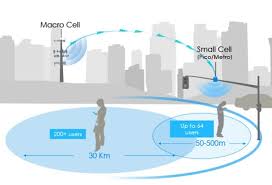

Small Cells in action
image ©5G Hub Technology inc.The classical view of mobile phone transmission is for large (macro) cells to be erected to cover a significant area (100 sq. km.) and we use these with our phones. Each of these macro cells has a capacity and one solution is to build another macro cell within the area access but the cell. This adds to the capacity over the whole area. But often what is needed is extra capacity in localised areas such as high streets, shopping malls, sports stadia. For these uses it seems over the top to build more and more macro cells.
Small cells are the size of a shoe box and can be mounted on street furniture such as lamp posts - hence the term smart lamp posts. They will be designed to add capacity in a buy area. Currently in the UK these will use frequencies in the 3.4-3.8GHz bands, and the power will be reduced so they serve a small area. Now this will invoke more cell handover, but it i=will be soft handover, and the usual use of these small cells will be to people who are either stationary or walking, hence the frequency of handover is not high. These cells do need a backhaul. They could use the macro cell (but this does not really solve the original problem); they could use some other form of radio frequency such as microwaves or Ulta Wide communications; or could capture a passing fibre cable.
Small cells will come more into their own when the UK releases the 26GHz waves. These will have a much greater capacity than 3.5GHz, and can be put to use in just the areas that small cells can add capacity.
© mobilephonetechnology.co.uk all rights reserved 2017-2025
